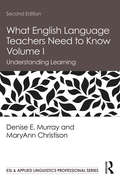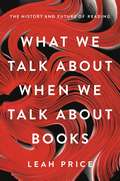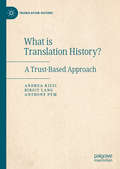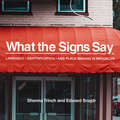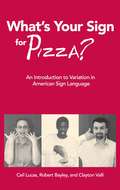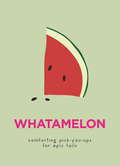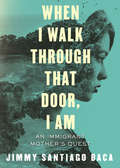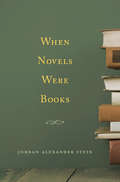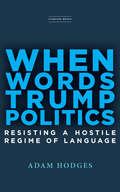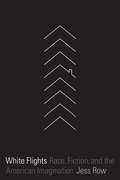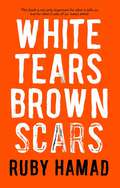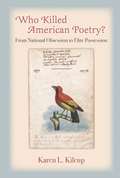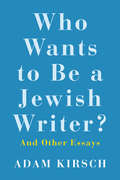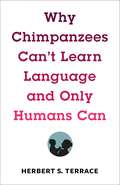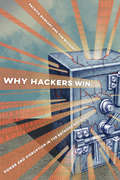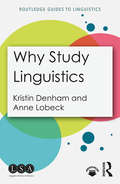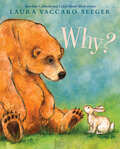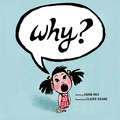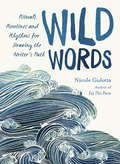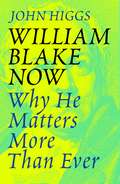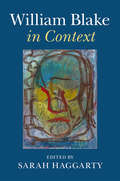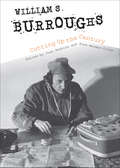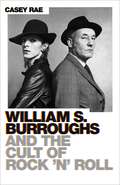- Table View
- List View
What English Language Teachers Need to Know Volume I: Understanding Learning (ESL & Applied Linguistics Professional Series)
by MaryAnn Christison Denise E. MurrayDesigned for pre-service teachers and teachers new to the field of ELT, What English Teachers Need to Know Volumes I, II, and III are companion textbooks organized around the key question: What do teachers need to know and be able to do in order for their students to learn English? In the Second Edition of Volume I, Murray and Christison return to this essential question and call attention to emerging trends and challenges affecting the contemporary classroom. Addressing new skills and strategies that EFL teachers require to meet the needs of their shifting student populations who are impacted by changing demographics, digital environments, and globalization, this book, which is grounded in current research, offers a strong emphasis on practical applications for classroom teaching. This updated and expanded Second Edition features: a new chapter on technology in TESOL new and updated classroom examples throughout discussions of how teachers can prepare for contemporary challenges, such as population mobility and globalization The comprehensive texts work for teachers across different contexts—where English is the dominant language, an official language, or a foreign language; for different levels—elementary/primary, secondary, university, or adult education; and for different learning purposes—general English, workplace English, English for academic purposes, or English for specific purposes.
What We Talk About When We Talk About Books: The History and Future of Reading
by Leah PriceReports of the death of reading are greatly exaggeratedDo you worry that you've lost patience for anything longer than a tweet? If so, you're not alone. <P><P>Digital-age pundits warn that as our appetite for books dwindles, so too do the virtues in which printed, bound objects once trained us: the willpower to focus on a sustained argument, the curiosity to look beyond the day's news, the willingness to be alone. <P><P>The shelves of the world's great libraries, though, tell a more complicated story. <P><P> Examining the wear and tear on the books that they contain, English professor Leah Price finds scant evidence that a golden age of reading ever existed. From the dawn of mass literacy to the invention of the paperback, most readers already skimmed and multitasked. <P><P>Print-era doctors even forbade the very same silent absorption now recommended as a cure for electronic addictions. The evidence that books are dying proves even scarcer. <P><P>In encounters with librarians, booksellers and activists who are reinventing old ways of reading, Price offers fresh hope to bibliophiles and literature lovers alike.
What is Translation History?: A Trust-Based Approach (Translation History)
by Anthony Pym Birgit Lang Andrea RizziThis book presents a dynamic history of the ways in which translators are trusted and distrusted. Working from this premise, the authors develop an approach to translation that speaks to historians of literature, language, culture, society, science, translation and interpreting. By examining theories of trust from sociological, philosophical, and historical studies, and with reference to interdisciplinarity, the authors outline a methodology for approaching translation history and intercultural mediation from three discrete, concurrent perspectives on trust and translation: the interpersonal, the institutional and the regime-enacted. This book will be of particular interest to students and scholars of translation studies, as well as historians working on mediation and cultural transfer.
What the Signs Say: Language, Gentrification, and Place-Making in Brooklyn
by Shonna Trinch Edward SnajdrAlthough we may not think we notice them, storefronts and their signage are meaningful, and the impact they have on people is significant. What the Signs Say argues that the public language of storefronts is a key component to the creation of the place known as Brooklyn, New York. Using a sample of more than two thousand storefronts and over a decade of ethnographic observation and interviews, the study charts two very different types of local Brooklyn retail signage. The unique and consistent features of many words, large lettering, and repetition that make up Old School signage both mark and produce an inclusive and open place. In contrast, the linguistic elements of New School signage, such as brevity and wordplay, signal not only the arrival of gentrification, but also the remaking of Brooklyn as distinctive and exclusive. Shonna Trinch and Edward Snajdr, a sociolinguist and an anthropologist respectively, show how the beliefs and ideas that people take as truths about language and its speakers are deployed in these different sign types. They also present in-depth ethnographic case studies that reveal how gentrification and corporate redevelopment in Brooklyn are intimately connected to public communication, literacy practices, the transformation of motherhood and gender roles, notions of historical preservation, urban planning, and systems of privilege. Far from peripheral or irrelevant, shop signs say loud and clear that language displayed in public always matters.
What's Your Sign for Pizza?: An Introduction to Variation in American Sign Language
by Ceil Lucas Robert Bayley Clayton ValliThis introductory text celebrates another dimension of diversity in the United States Deaf community — variation in the way American Sign Language (ASL) is used by Deaf people all across the nation. The different ways people have of saying or signing the same thing defines variation in language. In spoken English, some people say “soda,” others say “pop,” “Coke,” or “soft drink;” in ASL, there are many signs for “birthday,” “Halloween,” “early,” and of course, “pizza.” What’s Your Sign for Pizza? derives from an extensive seven-year research project in which more than 200 Deaf ASL users representing different ages, genders, and ethnic groups from seven different regions were filmed sharing their signs for everyday vocabulary. The film clips form a supplemental resource to the text and are referenced in their relevant chapters. The text begins with an explanation of the basic concepts of language and the structure of sign language. Each part of the text concludes with questions for discussion, and the final section offers three supplemental readings that provide further information on variation in both spoken and signed languages. What’s Your Sign for Pizza also briefly sketches the development of ASL, which explains the relationships between language varieties throughout the country. The videos are available online at www.youtube.com/GallaudetUniversityPress.
WhatAMelon: Comforting pick-you-ups for epic fails
by WhatAMelonIf you know a pearfect numpty who needs a bit of sage advice, chia them up with this little book of upbeat and adorkable fruit puns.#youokalehun?About the seriesThis cute and colourful series of fruit-pun-filled gift books are the perfect pick-me-ups for you, your friend or your partner in crime. Do you need to avocuddle, or are you grapeful for someone who's a bit of a melon? Then share the clove with these little books: AvoCuddle, WhataMelon, You are my Raisin for Living, Don't Give a Fig, I am Grapeful, You are 24 Carrot Gold.*veg, nuts and seeds are fair game
WhatAMelon: Comforting pick-you-ups for epic fails
by PyramidIf you know a pearfect numpty who needs a bit of sage advice, chia them up with this little book of upbeat and adorkable fruit puns.#youokalehun?About the seriesThis cute and colourful series of fruit-pun-filled gift books are the perfect pick-me-ups for you, your friend or your partner in crime. Do you need to avocuddle, or are you grapeful for someone who's a bit of a melon? Then share the clove with these little books: AvoCuddle, WhataMelon, You are my Raisin for Living, Don't Give a Fig, I am Grapeful, You are 24 Carrot Gold.*veg, nuts and seeds are fair game
When I Walk Through That Door, I Am: An Immigrant Mother's Quest
by Jimmy Santiago BacaPoet-activist Jimmy Baca immerses the reader in an epic narrative poem, imagining the experience of motherhood in the context of immigration, family separation, and ICE raids on the Southern border.Jimmy Santiago Baca sends us on a journey with Sophia, an El Salvadorian mother facing a mountain of obstacles, carrying with her the burden of all that has come before: her husband's murder, a wrenching separation from her young son at the border, then rape and abuse at the hands of ICE, yet persevering: "I keep walking/carrying you in my thoughts," she repeats, as she wills her boy to know she is on a quest to find him.
When Novels Were Books
by Jordan Alexander SteinThe novel was born religious, alongside Protestant texts produced in the same format by the same publishers. Novels borrowed features of these texts but over the years distinguished themselves, becoming the genre we know today. Jordan Alexander Stein traces this history, showing how the physical object of the book shaped the stories it contained.
When Words Trump Politics: Resisting a Hostile Regime of Language
by Adam HodgesTrumpism has not only ushered in a new political regime, but also a new regime of language—one that cries out for intelligent and informed analysis. When Words Trump Politics takes insights from linguistic anthropology and related fields to decode, understand, and ultimately provide non-expert readers with easily digestible tools to resist the politics of division and hate. Adam Hodges's short essays address Trump's Twitter insults, racism and white nationalism, "truthiness" and "alternative facts," #FakeNews and conspiracy theories, Supreme Court politics and #MeToo, Islamophobia, political theater, and many other timely and controversial discussions. Hodges breaks down the specific linguistic techniques and processes that make Trump's rhetoric successful in our contemporary political landscape. He identifies the language ideologies, word choices, and recurring metaphors that underlie Trumpian rhetoric. Trumpian discourse works in tandem with media discourse—Hodges shows how Trump often induces journalists and social media agents to recycle and strengthen his spectacular and misleading claims. Those who study democracy have long emphasized the need for an informed electorate. But being informed on political issues also demands a keen understanding of the way language is used to convey, discuss, debate, and contest those issues. When Words Trump Politics analyzes the political rhetoric of today. The actionable insights in this book give journalists, politicians, and all Americans the successful tools they need to respond to the politics of hate. When Words Trump Politics is an essential resource for political resistance, for anyone who cares about freeing democracy from the spell of demagoguery.
White Flights: Race, Fiction, and the American Imagination
by Jess RowA bold, incisive look at race and reparative writing in American fiction, by the author of Your Face in MineWhite Flights is a meditation on whiteness in American fiction and culture from the end of the civil rights movement to the present. At the heart of the book, Jess Row ties “white flight”—the movement of white Americans into segregated communities, whether in suburbs or newly gentrified downtowns—to white writers setting their stories in isolated or emotionally insulated landscapes, from the mountains of Idaho in Marilynne Robinson’s Housekeeping to the claustrophobic households in Jonathan Franzen’s The Corrections. Row uses brilliant close readings of work from well-known writers such as Don DeLillo, Annie Dillard, Richard Ford, and David Foster Wallace to examine the ways these and other writers have sought imaginative space for themselves at the expense of engaging with race.White Flights aims to move fiction to a more inclusive place, and Row looks beyond criticism to consider writing as a reparative act. What would it mean, he asks, if writers used fiction “to approach each other again”? Row turns to the work of James Baldwin, Dorothy Allison, and James Alan McPherson to discuss interracial love in fiction, while also examining his own family heritage as a way to interrogate his position. A moving and provocative book that includes music, film, and literature in its arguments, White Flights is an essential work of cultural and literary criticism.
White Tears/Brown Scars
by Ruby HamadWhen white people cry foul it is often people of colour who suffer. White tears have a potency that silences racial minorities. White Tears/Brown Scars blows open the inconvenient truth that when it comes to race, white entitlement is too often masked by victimhood. Never is this more obvious than the dealings between women of colour and white women. What happens when racism and sexism collide? Ruby Hamad provides some confronting answers.
Who Killed American Poetry?: From National Obsession to Elite Possession
by Karen L. KilcupThroughout the 19th century, American poetry was a profoundly populist literary form. It circulated in New England magazines and Southern newspapers; it was read aloud in taverns, homes, and schools across the country. Antebellum reviewers envisioned poetry as the touchstone democratic genre, and their Civil War–era counterparts celebrated its motivating power, singing poems on battlefields. Following the war, however, as criticism grew more professionalized and American literature emerged as an academic subject, reviewers increasingly elevated difficult, dispassionate writing and elite readers over their supposedly common counterparts, thereby separating “authentic” poetry for intellectuals from “popular” poetry for everyone else.\ Conceptually and methodologically unique among studies of 19th-century American poetry, Who Killed American Poetry? not only charts changing attitudes toward American poetry, but also applies these ideas to the work of representative individual poets. Closely analyzing hundreds of reviews and critical essays, Karen L. Kilcup tracks the century’s developing aesthetic standards and highlights the different criteria reviewers used to assess poetry based on poets’ class, gender, ethnicity, and location. She shows that, as early as the 1820s, critics began to marginalize some kinds of emotional American poetry, a shift many scholars have attributed primarily to the late-century emergence of affectively restrained modernist ideals. Mapping this literary critical history enables us to more readily apprehend poetry’s status in American culture—both in the past and present—and encourages us to scrutinize the standards of academic criticism that underwrite contemporary aesthetics and continue to constrain poetry’s appeal. Who American Killed Poetry? enlarges our understanding of American culture over the past two hundred years and will interest scholars in literary studies, historical poetics, American studies, gender studies, canon criticism, genre studies, the history of criticism, and affect studies. It will also appeal to poetry readers and those who enjoy reading about American cultural history.
Who Wants to Be a Jewish Writer?: And Other Essays
by Adam KirschFrom one of today’s keenest critics comes a collection of essays on poetry, religion, and the connection between the two Adam Kirsch is one of today’s finest literary critics. This collection brings together his essays on poetry, religion, and the intersections between them, with a particular focus on Jewish literature. He explores the definition of Jewish literature, the relationship between poetry and politics, and the future of literary reputation in the age of the internet. Several essays look at the way Jewish writers such as Stefan Zweig and Isaac Deutscher, who coined the phrase “the non‑Jewish Jew,” have dealt with politics. Kirsch also examines questions of spirituality and morality in the writings of contemporary poets, including Christian Wiman, Kay Ryan, and Seamus Heaney. He closes by asking why so many American Jewish writers have resisted that category, inviting us to consider “Is there such a thing as Jewish literature?”
Why Chimpanzees Can't Learn Language and Only Humans Can (Leonard Hastings Schoff Lectures)
by Herbert S. TerraceIn the 1970s, the behavioral psychologist Herbert S. Terrace led a remarkable experiment to see if a chimpanzee could be taught to use language. A young ape, named “Nim Chimpsky” in a nod to the linguist whose theories Terrace challenged, was raised by a family in New York and instructed in American Sign Language. Initially, Terrace thought that Nim could create sentences but later discovered that Nim’s teachers inadvertently cued his signing. Terrace concluded that Project Nim failed—not because Nim couldn’t create sentences but because he couldn’t even learn words. Language is a uniquely human quality, and attempting to find it in animals is wishful thinking at best. The failure of Project Nim meant we were no closer to understanding where language comes from.In this book, Terrace revisits Project Nim to offer a novel view of the origins of human language. In contrast to both Noam Chomsky and his critics, Terrace contends that words, as much as grammar, are the cornerstones of language. Retracing human evolution and developmental psychology, he shows that nonverbal interaction is the foundation of infant language acquisition, leading up to a child’s first words. By placing words and conversation before grammar, we can, for the first time, account for the evolutionary basis of language. Terrace argues that this theory explains Nim’s inability to acquire words and, more broadly, the differences between human and animal communication. Why Chimpanzees Can’t Learn Language and Only Humans Can is a masterful statement of the nature of language and what it means to be human.
Why Hackers Win: Power and Disruption in the Network Society
by Patrick Burkart Tom McCourtWhen people think of hackers, they usually think of a lone wolf acting with the intent to garner personal data for identity theft and fraud. But what about the corporations and government entities that use hacking as a strategy for managing risk? Why Hackers Win asks the pivotal question of how and why the instrumental uses of invasive software by corporations and government agencies contribute to social change. Through a critical communication and media studies lens, the book focuses on the struggles of breaking and defending the “trusted systems” underlying our everyday use of technology. It compares the United States and the European Union, exploring how cybersecurity and hacking accelerate each other in digital capitalism, and how the competitive advantage that hackers can provide corporations and governments may actually afford new venues for commodity development and exchange. Presenting prominent case studies of communication law and policy, corporate hacks, and key players in the global cybersecurity market, the book proposes a political economic model of new markets for software vulnerabilities and exploits, and clearly illustrates the social functions of hacking.
Why Study Linguistics (Routledge Guides to Linguistics)
by Kristin Denham Anne LobeckWhy Study Linguistics is designed to help anyone with an interest in studying language understand what linguistics is, and what linguists do. Exploring how the scientific study of language differs from other ways of investigating this uniquely human behavior, Why Study Linguistics: explores the various topics that students of linguistics study, including sound systems of language, the structure of words and sentences and their meanings, and the wider social context of language change and language variation; explains what you might do with a degree in linguistics and the kinds of jobs and careers that studying linguistics prepares you for; is supported by a list of links to additional resources available online. This book is the first of its kind and will be essential reading for anyone considering a course of study in this fascinating subject, as well as teachers, advisors, student mentors, and anyone who wants to know more about the scientific study of language.
Why?
by Laura Vaccaro SeegerFor young readers who always want to know why? . . . especially when there isn't an easy answer. An ALA Notable Children's BookA Capitol Choices Noteworthy TitleTwo-time Caldecott and Geisel Honoree Laura Vaccaro Seeger weaves a simple story about the unfailingly curious Rabbit-- and his patient friend Bear, who always answers his questions. Bear just wants to water his flowers, but Rabbit needs to know: why? Bear is looking forward to a peaceful night of stargazing, but all Rabbit cares about is: why? As spring passes into summer, and Rabbit continues to wonder why?, detailed, lush watercolor illustrations encourage the reader to figure out the reason for each question. Over and over, Bear gives the best answers he can-- until, in the depths of winter, he has no answer to give. This simple story is a reminder that even when there are no answers for our questions, we can count on trust and love-- and sometimes, that's more than enough.
Why?
by Adam RexThis sweet book will appeal to anyone familiar with the universal tendency of young children to always ask WHY? When supervillain Doctor X-Ray swoops in threatening to vanquish an innocent crowd, the only one brave enough not to run away is a little girl, who asks him simply, "Why?" He is taken aback—but he answers. She keeps asking. And he keeps answering—until a surprising truth is uncovered, and the villain is thwarted. In this laugh-out-loud take on the small-and-determined-beats-big-loud-bully story, simple questions lead to profound answers in a quest that proves the ultimate power of curiosity.
Wild Words: Rituals, Routines, and Rhythms for Braving the Writer's Path
by Nicole GulottaA guide for the next generation of writers—self-care rituals, creativity-generating rhythms, and personalized strategies for embracing a creative life.Wild Words is an invitation to explore the intersection of your writing practice with everything else in your busy life. Through personal stories and practical lessons you’ll learn how to enter a new relationship with your creativity, one that honors where you’ve been, where you’re headed, and where you are today. Discover methods to support a sustainable writing practice, clarifying and nourishing routines, an understanding of your own creative history, and guidance on how to make small but powerful mind-set shifts (such as how to see a career as a partner rather than an obstacle). Above all, Wild Words encourages you to approach creativity through a seasonal lens and helps you untangle the messy process of embracing your circumstances, trusting your voice, and making time to put pen to paper, season after season.
William Blake Now: Why He Matters More Than Ever
by John Higgs'If a thing loves, it is infinite' William BlakeA short, impassioned argument for why the visionary artist William Blake is important in the twenty-first centuryThe visionary poet and painter William Blake is a constant presence throughout contemporary culture - from videogames to novels, from sporting events to political rallies and from horror films to designer fashion. Although he died nearly 200 years ago, something about his work continues to haunt the twenty-first century. What is it about Blake that has so endured? In this illuminating essay, John Higgs takes us on a whirlwind tour to prove that far from being the mere New Age counterculture figure that many assume him to be, Blake is now more relevant than ever.
William Blake in Context (Literature in Context)
by Sarah HaggartyWilliam Blake, poet and artist, is a figure often understood to have 'created his own system'. Combining close readings and detailed analysis of a range of Blake's work, from lyrical songs to later myth, from writing to visual art, this collection of thirty-eight lively and authoritative essays examines what Blake had in common with his contemporaries, the writers who influenced him, and those he influenced in turn. Chapters from an international team of leading scholars also attend to his wider contexts: material, formal, cultural, and historical, to enrich our understanding of, and engagement with, Blake's work. Accessibly written, incisive, and informed by original research, William Blake in Context enables readers to appreciate Blake anew, from both within and outside of his own idiom.
William S. Burroughs Cutting Up the Century
by Joan Hawkins and Alex Wermer-ColanThis definitive book on Burroughs’ decades-long cut-up project and its relevance to the American twentieth century, including previously unpublished works.William S. Burroughs’s Nova Trilogy (The Soft Machine, Nova Express, and The Ticket That Exploded) remains the best-known of his textual cut-up creations, but he committed more than a decade of his life to searching out multimedia for use in works of collage. By cutting up, folding in, and splicing together newspapers, magazines, letters, book reviews, classical literature, audio recordings, photographs, and films, Burroughs created an eclectic and wide-ranging countercultural archive. This collection includes previously unpublished work by Burroughs such as cut-ups of work written by his son, cut-ups of critical responses to his own work, collages on the Vietnam War and the Watergate scandal, excerpts from his dream journals, and some of the few diary entries that Burroughs wrote about his wife, Joan.William S. Burroughs Cutting Up the Century also features original essays, interviews, and discussions by established Burroughs scholars, respected artists, and people who encountered Burroughs. The essays consider Burroughs from a range of perspectives—literary studies, media studies, popular culture, gender studies, post-colonialism, history, and geography.“A landmark in scholarship.” —Choice
William S. Burroughs and the Cult of Rock ’n’ Roll
by Casey RaeWilliam S. Burroughs’s fiction and essays are legendary, but his influence on music’s counterculture has been less well documented-until now. Examining how one of America’s most controversial literary figures altered the destinies of many notable and varied musicians, William S. Burroughs and the Cult of Rock ’n’ Roll reveals the transformations in music history that can be traced to Burroughs.
Wing Over Wing: Poems (Paraclete Poetry)
by Julie Cadwallader StaubWing Over Wing clears a path in the midst of everyday life to reveal the holy—whether catching fireflies at night, waiting at a bus stop, or experiencing the death of a loved one. This collection of beautiful poems lives at the intersection of the sacred and the ordinary, from the swirling flight of birds to conversations with the homeless. Wing Over Wing brims with compassion. The reader will find comfort and sustenance, as well as surprise and laughter, in these pages.
